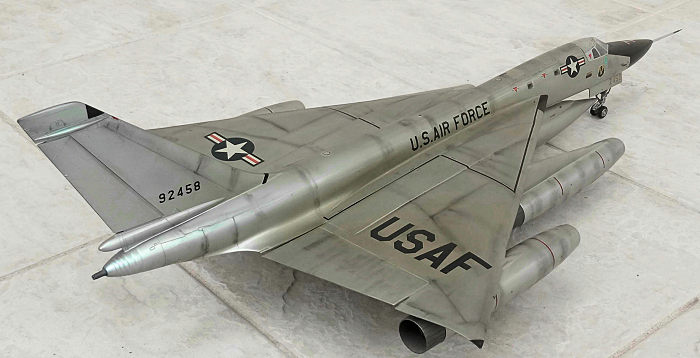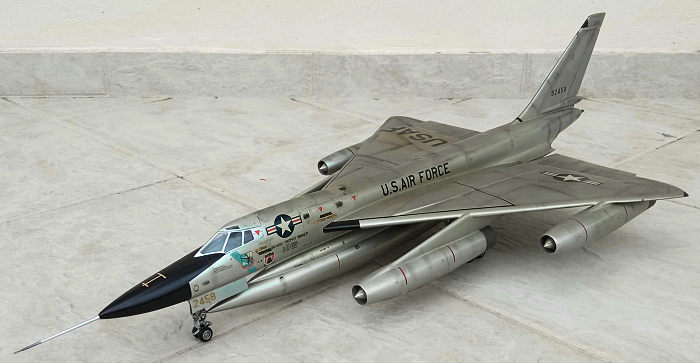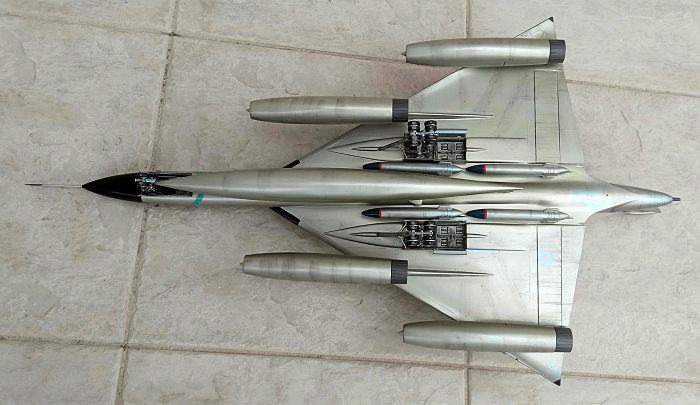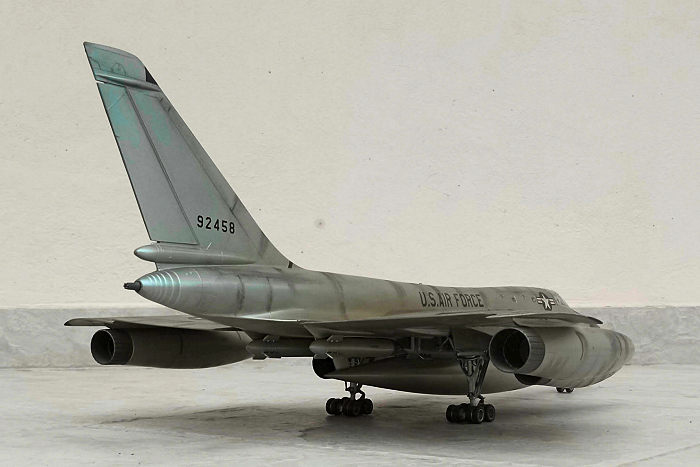
Monogram 1/48 B-58 Hustler
| KIT #: | 5704 |
| PRICE: | $35.00 |
| DECALS: | One option |
| REVIEWER: | Spiros Pendedekas |
| NOTES: |

| HISTORY |
The origins of the B-58 can be traced back in 1949,
when the Air Research and Development Command (ARDC) issued the Generalized
Bomber Study (GEBO II), calling for the development of a long range supersonic
bomber.
Convair’s initial proposal, called “FZP-110”, was a slender delta configuration,
utilizing three J53 engines. The design converged to "MX-1964”, featuring four
underwing hanged J-79 turbojets and it was this design that enabled Convair
earning by the end of 1952 the contract to build the “GEBO". The plane was
designated B-58, with the name “Hustler” reportedly originating from Convair’s
high rank engineer E. Stanton Brown’s response upon being informed on the
aircraft’s advanced characteristics and performance.
With the program taking place in high secrecy, the first prototype took to the
air on 11 November 1956 and by the end of December it broke the sound barrier.
Development of the cutting-edge machine was long and troublesome, involving no
less than 30 trial prototypes built, with the aircraft finally becoming
operational by the end of summer 1960.
 The Hustler
was operated by a crew of three: pilot, radar navigator/bombardier and defense
systems operator, all seated in separated tandem cockpits, with both rear
positions being cramped and notoriously claustrophobic. In later versions, each
crew member featured a distinctive High Altitude/Mach2 ejection capsule.
The Hustler
was operated by a crew of three: pilot, radar navigator/bombardier and defense
systems operator, all seated in separated tandem cockpits, with both rear
positions being cramped and notoriously claustrophobic. In later versions, each
crew member featured a distinctive High Altitude/Mach2 ejection capsule.
The aerodynamically slender machine incorporated a large but thin delta wing
with a 60° sweep angle, easily allowing it to fly within the Mach cone. Aluminum
honeycomb panels were extensively used, achieving a notably lightweight
structure, while the engine nacelles were equipped with variable air intakes to
maximize efficiency at all speeds. Another interesting feature was that, apart
from the crew compartment, the electronics bay and the wheel wells were
pressurized and air conditioned, to counter the high speed generated heat.
The electronics, including cockpit aids, were vastly sophisticated for the era.
In particular, the Sperry AN/ASQ-42 bombing/navigation platform, which combined
an astro-inertial navigation system, a doppler, a search radar and a radar
altimeter, was way ahead of its time, estimated to be 10 times more accurate
than any previous system.
The plane’s ordnance was equally distinctive. Initially, a single nuclear weapon
would be carried in a streamlined “MB-1C” pod under the fuselage, which
contained extra fuel. At some time the Two Component Pod (TCP) was introduced,
having the same profile and using the same attachment points as the MB-1C, but,
internally, placing the nuclear weapon in an upper and the fuel in a lower
section, with the latter capable of being independently jettisoned, allowing,
among others, "cleaning-up" the aircraft for fuel efficiency or in case of
emergency, while still retaining the weapon. Both pods were used till the
plane’s retirement, with the TCP being the preferable one, as it surpassed the
MB-1C in all aspects but nuclear warhead size. During the early 60s, a provision
to carry four Mk. 43 thermonuclear bombs underneath the wing roots in tandem
pairs was also implemented. Defensive armament consisted of a highly automated,
radar linked, rear firing T-171E-3 rotary cannon with 1,200 rounds of ammunition
in a radar-aimed tail barbette
Although theoretically capable for conventional strikes, the type was never
assigned to. Other potential uses included the use of specialized pods to carry
out photo reconnaissance or electronic countermeasures and also use as a
platform to carry early cruise, ballistic and anti-satellite missiles. All above
projects were worked to a degree but none materialized. Due to its size and
performance, the plane was frequently used as a test platform for several
“special trials” (like pods development).
Upon gaining operational status, the Hustler quickly started to show its
potential, excelling in both high-level and low-level radar bombing exercises.
However, competition from the B-47 and, especially, the B-52 was strong, not in
absolute terms of flight performance, but as a complete “package”, which
included, among others, weapons sizes and operating costs. The plane was very
expensive to acquire and maintain (a classic example was the special maintenance
for the nose landing gear, which retracted in a complex fashion to avoid the
center payload which stood at close proximity).
 The plane’s
high accident rate (with, however, more than half of the losses having occurred
during flight tests) did not help either, with the SAC’s senior leadership being
skeptical of the bomber’s viability. General Curtis Le May himself was
reportedly never being fully satisfied with the plane, considering it “too
small, far too expensive to maintain in combat readiness and requiring an
excessive number of aerial refuelings to complete a mission”.
The plane’s
high accident rate (with, however, more than half of the losses having occurred
during flight tests) did not help either, with the SAC’s senior leadership being
skeptical of the bomber’s viability. General Curtis Le May himself was
reportedly never being fully satisfied with the plane, considering it “too
small, far too expensive to maintain in combat readiness and requiring an
excessive number of aerial refuelings to complete a mission”.
In any case, with its teething issues systematically addressed, the plane
started to somehow solidify with the SAC with time. However, its dodgy road
seemed to be never ending, as the increasing threat posed by the extensively
deployed high-altitude Soviet surface-to-air missiles, especially the SA-2
Guideline, necessitated the switch to low altitude flying, where the bird could
not fly supersonic, thus putting in question the necessity of its aggravated
operating and maintenance costs required for its supersonic profile mission it
would no longer be assigned at. Secretary of Defense Robert McNamara regarded
the B-58 a non-viable weapon system, mainly due to extreme operating costs,
ordering in late 1965 its retirement by 1970, something that, despite some
reprieving efforts, took place by January of that year.
Despite the high workload and the challenging flight characteristics, the
hot-performing plane was loved by its crews: once learning how to tackle the
idiosyncratic machine, the crews became enthusiastic with it. Interestingly for
a delta, its high-speed performance at low altitude was excellent. The plane set
19 speed records, including cross-US, and the longest supersonic flight in
history. Due to their experience gained at long supersonic flights, a number of
B-58 pilots were selected to fly the SR-71. In total, 116 B-58s were produced.
The B-58 was undoubtedly an engineering marvel, an extremely aggressive,
visually striking design of the times. Tailored to very strict and aggressive
requirements, it was expensive to build and, particularly, to operate. Once its
design mission profile was rendered obsolete and with the practical options to
viably undertake other missions being thin, the aesthetically pleasing Delta
Lady's days were soon to be over.
| THE KIT |
 Monogram came
in 1985 with its quarter scale B-58, which was reboxed another five times ever
since, the last one being in 2010 by Revell. A nice yet challenging kit to build
due to its size and less than perfect fit. The specific copy is the 1999
edition, bought in 2002 from one of my hometown’s now closed hobby shops at a
good price and for a look at its contents you might look no further than our
Editor’s thorough preview,
found at the ever growing MM archives.
Monogram came
in 1985 with its quarter scale B-58, which was reboxed another five times ever
since, the last one being in 2010 by Revell. A nice yet challenging kit to build
due to its size and less than perfect fit. The specific copy is the 1999
edition, bought in 2002 from one of my hometown’s now closed hobby shops at a
good price and for a look at its contents you might look no further than our
Editor’s thorough preview,
found at the ever growing MM archives.
| CONSTRUCTION |
I started by attaching the tiny side windows from the
top fuselage innards, then joined that fuselage part with the impressive
one-piece upper wing half. The very nice 10-piece front cockpit was then
assembled. Since its floor doubles as a nose well top, the rear well wall was
attached to it. Once completed it was glued to the lower fuselage half, which,
in turn, was attached to the upper fuselage/wing subassembly. While not
mentioned in the instructions, just to be sure (and trusting Monogram’s nose
gear rigidity) I trapped around 30 grams of fishing weights in the nose.
Basic cockpit color was Hu140 Gull Gray with black instrument panel and console
faces. All raised instrumentation was highlighted by silver dry brushing, with a
few “knobs” done by “pinning” red, yellow and white paint. The very nice seat
(which is in fact an escape capsule) featured the same cockpit basic color, red
cushions and gray seat belts. As a note, no interior is provided for the
navigator and the DSO, with the tiny windows reassuring that the internal
emptiness will be totally unnoticed.
 The massive
lower wing half had its main well roofs attached to its innards and attached
the completed subassembly to the upper wing half. The tail was also assembled
and attached to the rear.
The massive
lower wing half had its main well roofs attached to its innards and attached
the completed subassembly to the upper wing half. The tail was also assembled
and attached to the rear.
The four engines were next assembled and attached in position. Their nozzles
were left out, to be attached at later stages. The two ejector racks for the
four externally carried Mk.43 thermonuclear bombs were then attached (if you
decide not to use them, the corresponding wing cutouts have to be filled). The
four Mk.43s themselves were also assembled, together with the central Two
Component Pod - TCP (you also have the option to assemble and attach the smaller
central bomb alone).
This concluded basic airframe and weapons assembly. Fit was in many areas
challenging, something more or less expected from an older tooling of a complex
shaped big jet. Almost every joint needed attention, with the size of parts and
the Natural Metal Finish requirement imposing an extra challenge. Being
prepared, I went on and gave the model multiple rounds of filling and sanding
until I felt that the result would be sort of homogenous.
Since the bird’s complex landing gear would also be NMF, I decided to attach all
its parts (sans the main accumulators, which would be black), together with the
doors to the model and paint everything together. This would mean that all
innards would also be NMF, in contrast with instructions that stated gray.
However, by looking at net pics of unrestored birds, I figured that bay and door
innards featured a rather metallic gray color. This would be sufficient for my
lazy attitude, as I would easily paint everything NMF and apply a matt varnish
at the “metallic gray” areas. It was by that time that I masked the
transparencies and happily took the bird to the paint shop!
| COLORS AND MARKINGS |
 I first
painted black the radome, front anti glare and a few dielectric areas at the
wing tips, the rots and fin. After masking them off, I gave the complete bird,
including the attached landing gear legs and doors, the engine faces and also
the TCP pod and the four Mk.43s a coat of my trusty Hu11 Silver. Upon drying I
proceeded to decaling.
I first
painted black the radome, front anti glare and a few dielectric areas at the
wing tips, the rots and fin. After masking them off, I gave the complete bird,
including the attached landing gear legs and doors, the engine faces and also
the TCP pod and the four Mk.43s a coat of my trusty Hu11 Silver. Upon drying I
proceeded to decaling.
I used the kit decals to represent the #92458 machine, which won the Bendix
Trophy on March 5, 1962, flying from Los Angeles to New York City in 2 hours and
56.8 seconds with an average speed of 1214.17 miles per hour. Apart from some
yellowing of their carrier film and some milky residue that was easily wiped
off, the decals behaved nicely, easily detaching and nicely adhering to the
silver coated area. A coat of Future sealed them.
| FINAL BITS |
All 10 wheels were assembled and attached in position.
With some tweaking, it became possible for all of them to touch the ground. They
were filed to look more "natural" (though, really, not “weighted” as they were
inflated to very high pressures). They had silver rims and black tires. The main
landing gear accumulators were painted dark blue and attached within the main
bays.
The TCP pod was attached in position, as were the Mk.43 bombs. To add some
flavor, I decided to paint the latter's domes dark blue and apply a red striped
decal at the blue/silver demarcation lines (of course, this painting has good
chances to be “wrong”, as pure aluminum, pure white or even “green leaf” has
been stated/observed and domes were
 also seen in
black or dark blue - those weapons were surrounded by relative secrecy and their
painting could, at times, be deceptive). Finally, the four exhaust nozzles had
their flame holders affixed and, after painted Testors Burned Metal, were
attached in position.
also seen in
black or dark blue - those weapons were surrounded by relative secrecy and their
painting could, at times, be deceptive). Finally, the four exhaust nozzles had
their flame holders affixed and, after painted Testors Burned Metal, were
attached in position.
Those birds were kept in pristine condition, with photographic evidence
justifying it, so the only weathering applied was a black wash at the landing
gear area to accentuate its details. Since I am too lazy to go with various NMF
shades, I run dark colored pastels over various aerodynamic surfaces and
fuselage panel lines to breathe some life to the monotonous NMF, with a gloss
coat giving the bird its final hue.
The three piece canopy was assembled and, after having its well defined framing
hand painted, was attached in position, with fit being good. The big pitot had
its body painted silver and its tip Testors Burned Metal and attached in
position. The rear cannon was also painted Testors Burned Metal and attached.
Tiny blobs of red and green paint represented the wingtip lights and top beacon,
before calling the Hustler done!
| CONCLUSIONS |
No one but Monogram could have dared to come up with a
quarter scale Hustler from as early as 1985 (and, as of 2024, we have to see if
anyone will come up with one in the future). Judged in absolute terms, this is
definitely a decent kit of the iconic Hustler: overall shape looks spot-on,
molding is good, panel lines, though raised, are correctly depicted, overall
detail is great with the key areas of pilot cockpit and landing gear nicely
represented, decals were tad yellowed but otherwise behaved well, transparencies
were nice and clear and instructions were comprehensive.
On the minus side, fit needs its attention at areas (but, remember, this is a
1985 big jet model mold with many complex shaped areas). Also, there’s
absolutely no detail for the rear crew compartments, so, if you want to open
them up, there’s some serious work in front of you. Some of us would also wish
for more detail in the engine exhausts and, especially, the intakes. Maybe it
all has to do with the Monogram style, i.e. provide a decent, not over
engineered kit with great detail at key areas and at an affordable price. Should
you wish to go aftermarket you will be definitely pleased, as there is quite
some stuff available to boost the kit looks. Definitely not for a beginner, this
kit can be turned into a masterpiece as can be seen in Lee Colosna’s build.
Till someone else comes up with a newer tooling (you never know - we did see a
new tool quarter scale SR-71 in 2021, didn’t we?), the Monogram will be your
only option, promising to deliver a beautiful representation of the
aesthetically pleasing Hustler, provided you are not a beginner and willing to
walk the extra mile of tackling the fit challenges the kit poses.
Happy Modeling!
Spiros Pendedekas
22 April 2024
Copyright ModelingMadness.com. All rights reserved. No reproduction in part or in whole without express permission.
If you would like your product reviewed fairly and fairly quickly, please contact the editor or see other details in the Note to Contributors.